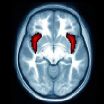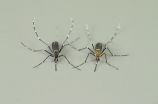(Press-News.org) A study that looked at predicting suicides in U.S. Army soldiers after they are hospitalized for a psychiatric disorder suggests that nearly 53 percent of posthospitalization suicides occurred following the 5 percent of hospitalizations with the highest predicted suicide risk, according to a report in JAMA Psychiatry.
The suicide rate in the U.S. Army has increased since 2004 and now exceeds the rate among civilians. Still, suicide is a rare outcome even among recently discharged psychiatric patients. A potentially promising approach to assess posthospitalization suicide risk would be to use administrative data to generate an actuarial posthospitalization suicide risk algorithm. Previous research has suggested that actuarial suicide prediction is more accurate than predictions based on clinical judgment, according to background information in the study.
Researcher Ronald C. Kessler, Ph.D., of Harvard Medical School, Boston, and co-authors sought to develop such an algorithm for predicting suicide in the 12 months after a soldier was hospitalized for a psychiatric disorder so that expanded posthospitalization care might be targeted to soldiers classified as having high suicide risk. A variety of administrative data were used. There were 53,769 hospitalizations of active duty soldiers from January 2004 through December 2009 with psychiatric admission diagnoses.
The study results indicate that 68 soldiers died by suicide within 12 months of being discharged from the hospital (12 percent of all U.S. Army suicides), which is equivalent to 263.9 suicides per 100,000 person-years compared with 18.5 suicides per 100,000 per-years in the total U.S. Army.
Researchers found the strongest predictors included sociodemographic factors such as being male, late-age of enlistment, criminal offenses, weapons possession, prior suicidality, aspects of prior psychiatric treatment (such as the number of antidepressant prescriptions filled in 12 months) and disorders diagnosed during the hospitalizations.
A total of 52.9 percent of the posthospitalization suicides occurred after the 5 percent of hospitalizations with the highest predicted suicide risk (3824.1 suicides per 100,000 person-years), according to the study. Soldiers in the highest predicted suicide risk stratum (group) had seven unintentional injury deaths, 830 suicide attempts and 3,765 subsequent hospitalizations within 12 months of hospital discharge.
"Although interventions in this high-risk stratum would not solve the entire U.S. Army suicide problem given that posthospitalization suicides account for only 12 percent of all U.S. Army suicides, the algorithm would presumably help target preventive interventions. Before clinical implementation, though, several key issues must be addressed," the researchers note.
The authors conclude: "The high concentration of risk of suicides and other adverse outcomes might justify targeting expanded posthospitalization interventions to soldiers classified as having highest post-hospitalization suicide risk, although final determination requires careful consideration of intervention costs, comparative effectiveness and possible adverse effects."
INFORMATION:
(JAMA Psychiatry. Published online November 12, 2014. doi:10.1001/jamapsychiatry.2014.1754. Available pre-embargo to the media at http://media.jamanetwork.com.)
Editor's Note: Authors made conflict of interest disclosures. The Army STARRS was sponsored by the U.S. Department of the Army and funded under a cooperative agreement with the National Institute of Mental Health, National Institutes of Health, U.S. Department of Health and Human Services. Please see the article for additional information, including other authors, author contributions and affiliations, financial disclosures, funding and support, etc.
Media Advisory: To contact author Ronald C. Kessler, Ph.D., call David Cameron at 617-432-0441 or email david_cameron@hms.harvard.edu
SEATTLE - Preterm birth is now the leading cause of death for children under 5 worldwide, and a new scientific paper reveals a startling lack of knowledge about what causes it and how to prevent it.
Published in the November issue of Science Translational Medicine, "Prevention of Preterm Birth: Harnessing Science to Address the Global Epidemic" shines a light on the urgent need for a larger, coordinated research effort to discover how to identify women at risk of preterm birth and develop prevention interventions.
"There are not enough resources dedicated to researching ...
Older women with disordered breathing during sleep were found to be at greater risk of decline in the ability to perform daily activities, such as grocery shopping and meal preparation, according to a new study led by researchers at the Johns Hopkins Bloomberg School of Public Health and the University of California, San Francisco.
The study was published Nov. 6 in the online edition of the Journal of the American Geriatrics Society.
The findings are notable given the aging of the population - an estimated 3.7 million Americans will turn 65 in 2015, and by 2030, 19 ...
In school-age children previously diagnosed with depression as preschoolers, a key brain region involved in emotion is smaller than in their peers who were not depressed, scientists have shown.
The research, by a team at Washington University School of Medicine in St. Louis, also suggests that the size of the brain's right anterior insula may predict the risk of future bouts of depression, potentially giving researchers an anatomical marker to identify those at high risk for recurrence.
The study is published online Nov. 12 in the journal JAMA Psychiatry.
There is ...
One of the world's deadliest mosquitoes sustains its taste for human blood thanks in part to a genetic tweak that makes it more sensitive to human odor, according to new research.
Researchers report in the journal Nature that the yellow fever mosquito contains a version of an odor-detecting gene in its antennae that is highly attuned to sulcatone, a compound prevalent in human odor. The researchers found that the gene, AaegOr4, is more abundant and more sensitive in the human-preferring "domestic" form of the yellow fever mosquito than in its ancestral "forest" form that ...
Adding tiny amounts of vegetable puree to milk and then rice at the time of weaning makes children more likely to eat vegetables, new University of Leeds research shows.
Infants who consumed either milk (breast milk or formula) followed by rice mixed with vegetable puree ate nearly half as many vegetables again as infants who ate just milk followed by baby rice.
Professor Marion Hetherington, of the School of Psychology at the University of Leeds, led the study. She said: "We took inspiration from French mothers, as previous studies in this area have shown that they ...
(SACRAMENTO, Calif.) -- In its first clinical application in pediatric patients, an investigational medication developed and manufactured at UC Davis has been found to effectively treat children with life-threatening and difficult-to-control epileptic seizures without side effects, according to a research report by scientists at UC Davis and Northwestern University.
The investigational formulation of allopregnanolone was manufactured by UC Davis Health System's Good Manufacturing Practice Laboratory. Two children were treated with the allopregnanolone formulation, one ...
LA JOLLA, CA - November 12, 2014 - Driving to work becomes routine--but could you drive the entire way in reverse gear? Humans, like many animals, are accustomed to seeing objects pass behind us as we go forward. Moving backwards feels unnatural.
In a new study, scientists from The Scripps Research Institute (TSRI) reveal that moving forward actually trains the brain to perceive the world normally. The findings also show that the relationship between neurons in the eye and the brain is more complicated than previously thought--in fact, the order in which we see things ...
(MEMPHIS, Tenn. - November 12, 2014) An international collaboration has identified frequent mutations in two genes that often occur together in Ewing sarcoma (EWS) and that define a subtype of the cancer associated with reduced survival. The research, conducted by the St. Jude Children's Research Hospital-Washington University Pediatric Cancer Genome Project and the Institut Curie-Inserm through the International Cancer Genome Consortium, appears in the current issue of the scientific journal Cancer Discovery.
Mutations in the genes STAG2 and TP53 have previously been ...
Giant otters may have a vocal repertoire with 22 distinct vocalization types produced by adults and 11 neonate vocalization types, according to a study published November 12, 2014 in the open-access journal PLOS ONE by Christina Mumm and Mirjam Knörnschild from University of Ulm, Germany.
Giant otters, found in South America, are very social and frequently vocalizing animals. They live in groups that may vary, but generally include a reproductive pair and their offspring, born in different years. Individuals engage in shared group activities and hold different social ...
Using fewer than twenty genomes, researchers were unable to find rare protein-altering variants significantly associated with extreme longevity, according to a study published November 12, 2014 in the open-access journal PLOS ONE by Hinco Gierman from Stanford University and colleagues.
Supercentenarians are the world's oldest people, living beyond 110 years of age. Seventy-four are alive worldwide, with twenty-two living in the United States. The authors of this study performed whole-genome sequencing on 17 supercentenarians to explore the genetic basis underlying ...


